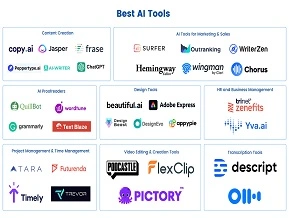Top Skills Every Data Scientist in Artificial Intelligence Must Master
What Does a Data Scientist in Artificial Intelligence Actually Do?
A data scientist artificial intelligence professional plays a crucial role in turning raw data into intelligent, actionable outcomes. By combining data science techniques with AI technologies, they help build smarter systems that can learn, adapt, and improve over time.
Analysing Complex Datasets for AI Insights
One of the core responsibilities of a data scientist working in AI is to analyse large and complex datasets. They extract meaningful patterns, trends, and anomalies that form the foundation for AI models. This involves advanced statistical analysis, data cleaning, and feature engineering to ensure the data is ready for model training.
Designing and Testing Machine Learning Models
A key aspect of the role is building and refining machine learning (ML) models. These models allow systems to make predictions, classify information, and automate decisions. A data scientist may experiment with different algorithms—such as decision trees, neural networks, or support vector machines—to determine the best fit for a given problem.
Bridging Data Science, Software Engineering, and AI Research
The AI and data scientist role lies at the intersection of multiple disciplines. In addition to data analysis and modeling, they often work closely with software engineers to deploy models into production environments. They also stay up to date with the latest AI research to apply cutting-edge techniques to practical challenges.
Solving Business Problems with AI Solutions
Ultimately, a data scientist in artificial intelligence transforms business problems into AI-driven solutions. Whether it's improving customer experiences, optimizing operations, or forecasting market trends, they align technical approaches with business goals to deliver real-world value.
In summary, this role is a blend of analytical thinking, technical skill, and strategic insight—making the data scientist in AI a key player in today’s intelligent, data-powered world.
Why is Programming a Core Skill for AI and Data Scientists?
Programming is a fundamental skill for any data scientist artificial intelligence professional. It serves as the backbone for developing, testing, and deploying AI models that solve real-world problems. Without strong programming abilities, transforming theoretical AI concepts into practical applications becomes challenging.
Python: The Language of Choice
Python has emerged as the dominant programming language in AI and data science due to its simplicity and extensive ecosystem. Its rich libraries, such as TensorFlow, PyTorch, scikit-learn, and Keras, provide powerful tools for building machine learning and deep learning models efficiently. This makes Python a preferred language for data scientists working on AI projects.
Expanding Skills with R, SQL, and More
While Python is essential, proficiency in other languages like R and SQL adds valuable flexibility. R is particularly useful for statistical analysis and visualization, while SQL is critical for managing and querying databases. In some cases, knowledge of Java or C++ is beneficial for performance-intensive AI applications, especially when integrating AI models into larger software systems.
Writing Clean and Scalable Code
An AI and data scientist must write clean, efficient, and scalable code to ensure AI models can be deployed and maintained effectively. Code quality affects model reproducibility, debugging, and collaboration with other team members. Additionally, understanding software development best practices improves the transition from prototype to production.
Understanding APIs and Integration
Finally, familiarity with APIs (Application Programming Interfaces) and integration techniques is a major plus. Many AI models need to be embedded within existing systems or deployed as services accessible via APIs. This knowledge enables data scientists to deliver end-to-end AI solutions that function seamlessly in production environments.
In conclusion, programming skills empower data scientists in artificial intelligence to turn data into actionable, scalable, and reliable AI-powered solutions.
How Important is Machine Learning Knowledge for a Data Scientist in Artificial Intelligence?
Machine learning (ML) knowledge is absolutely essential for a data scientist artificial intelligence professional. Since ML forms the core of many AI systems, a strong grasp of its concepts and algorithms is critical to designing models that can learn from data and make accurate predictions.
Mastery of Foundational Algorithms
A data scientist in AI must be proficient with fundamental ML algorithms such as linear regression, decision trees, support vector machines (SVMs), and k-nearest neighbours. These algorithms form the building blocks for solving a wide range of problems, from classification to regression. Understanding how these algorithms work, their assumptions, strengths, and limitations is crucial for selecting the right approach for each project.
Choosing Between Supervised and Unsupervised Learning
Equally important is knowing when to apply supervised learning versus unsupervised learning techniques. Supervised learning relies on labelled data and is commonly used for prediction and classification tasks. Unsupervised learning, on the other hand, helps discover hidden patterns and groupings in unlabelled data, such as clustering or dimensionality reduction. Making the right choice between these approaches significantly impacts model effectiveness.
Practical Skills in Model Evaluation and Optimization
Beyond theory, practical experience with evaluating and optimizing models is expected. This includes techniques such as cross-validation, hyper parameter tuning, and metrics analysis to ensure that models generalize well and avoid overfitting. A skilled data scientist continually refines models to improve accuracy and robustness.
Value of Ensemble Methods
Familiarity with ensemble methods like boosting and bagging is highly valuable. These techniques combine multiple models to create stronger predictive performance and reduce variance or bias. Ensemble learning is widely used in competitions and real-world applications for its effectiveness.
In summary, deep machine learning knowledge empowers data scientists to build sophisticated AI solutions that are both accurate and reliable.
What Role Does Data Wrangling and Pre-processing Play for AI and Data Scientists?
Data wrangling and pre-processing are fundamental steps in any AI or data science project. For an AI and data scientist, these tasks often make up around 80% of the work, as raw data is rarely clean or structured enough for immediate analysis or modelling.
Cleaning, Formatting, and Structuring Data
The initial phase involves cleaning the data by removing duplicates, correcting errors, and formatting it consistently. Structuring the data into a usable format, such as tabular form, is essential before feeding it into machine learning models. Without thorough cleaning and formatting, the results can be misleading or inaccurate.
Feature Selection and Engineering
Once the data is clean, feature selection and engineering become crucial. This involves choosing the most relevant variables and creating new features that better capture underlying patterns in the data. Well-engineered features can significantly enhance model performance by improving its ability to detect meaningful relationships.
Handling Missing Data and Outliers
Missing data and outliers can distort analysis and degrade model accuracy. Effective handling strategies include imputation techniques to fill gaps and methods to detect and address outliers. Proper treatment ensures the robustness and reliability of the AI models.
Tools and Workflow Automation
To streamline these tasks, AI and data scientists often use powerful tools like Pandas and NumPy for data manipulation. Automated data pipelines help standardize and accelerate pre-processing, enabling smoother workflows and faster iteration cycles.
In summary, data wrangling and pre-processing are critical to building successful AI models. By investing time in these foundational steps, AI and data scientists lay the groundwork for accurate insights and impactful machine learning solutions.
How Can a Data Scientist in Artificial Intelligence Leverage Big Data Technologies?
A data scientist artificial intelligence professional must effectively manage and analyze massive datasets to build robust AI models. Leveraging big data technologies is essential to handle the volume, velocity, and variety of data common in today’s AI-driven projects.
Distributed Computing with Hadoop and Spark
Understanding distributed computing frameworks like Hadoop and Apache Spark is crucial. These platforms allow data scientists to process large datasets across multiple machines efficiently. Spark, in particular, offers in-memory processing that accelerates data analytics and machine learning tasks, enabling faster experimentation and model training.
Working with Big Data Tools
Experience with big data query and processing tools such as Hive and Pig allows data scientists to manipulate structured and semi-structured data stored in distributed file systems. Additionally, Python libraries like Dask help scale data processing on single or multiple machines, making it easier to work with data that doesn’t fit into memory.
Cloud Platforms for Scalable Infrastructure
Cloud services like AWS, Google Cloud Platform (GCP), and Microsoft Azure provide scalable infrastructure and managed big data tools that simplify deployment and collaboration. These platforms offer AI-focused services, including managed machine learning, data lakes, and serverless computing, which accelerate AI project timelines.
Real-Time Data Processing
For AI applications requiring immediate insights, real-time data processing technologies such as Apache Kafka and Apache Flink enable streaming data ingestion and analysis. These tools support use cases like fraud detection, recommendation systems, and predictive maintenance by providing low-latency data pipelines.
In summary, a data scientist in artificial intelligence who leverages big data technologies can efficiently scale their AI solutions, process vast amounts of data, and enable faster, more accurate decision-making.
Why are Deep Learning and Neural Networks Essential for AI and Data Scientists Today?
Deep learning and neural networks have become fundamental components for any AI and data scientist working on cutting-edge artificial intelligence projects. These technologies power some of the most advanced AI applications in fields like computer vision, natural language processing (NLP), and speech recognition.
The Power of Neural Networks in Modern AI
Neural networks, particularly deep neural networks, mimic the human brain’s structure and function to identify complex patterns in data. Convolutional Neural Networks (CNNs) excel in image and video analysis, enabling breakthroughs in facial recognition and autonomous vehicles. Recurrent Neural Networks (RNNs) and transformers are widely used for sequential data like text and speech, forming the backbone of language models and translation systems.
Essential Familiarity with Key Architectures
For AI and data scientists, familiarity with architectures such as CNNs, RNNs, Long Short-Term Memory networks (LSTMs), and transformers is critical. Understanding these models’ strengths and weaknesses allows professionals to select and tailor architectures to specific AI tasks.
Hands-On Experience with Leading Frameworks
Frameworks like TensorFlow and PyTorch are industry standards for building, training, and deploying deep learning models. Proficiency with these tools enables data scientists to develop scalable AI solutions efficiently. These frameworks also support model fine-tuning, making it easier to adapt pre-trained models to new datasets or domains.
Training and Interpreting Deep Learning Models
Training deep learning models requires expertise in hyperparameter tuning, optimization algorithms, and managing computational resources. Additionally, interpreting model outputs and understanding potential biases have become vital skills, ensuring AI systems are reliable and ethical.
In conclusion, deep learning and neural networks are indispensable tools that empower AI and data scientists to push the boundaries of what artificial intelligence can achieve today.
How Do Business Acumen and Communication Skills Empower a Data Scientist in Artificial Intelligence?
A successful data scientist ai professional goes beyond technical expertise by mastering business acumen and communication skills. These abilities are critical for bridging the gap between complex AI models and real-world business impact.
Translating Complex Models into Business Value
One of the key differentiators for a data scientist in AI is the ability to translate intricate machine learning models and statistical outputs into clear business value. This means understanding the strategic goals of the organization and aligning AI solutions accordingly to solve relevant problems or unlock new opportunities.
The Power of Data Storytelling
Data storytelling plays a vital role in communicating findings to non-technical stakeholders. By presenting insights through compelling narratives, visualizations, and simple explanations, data scientists ensure their work drives informed decision-making at all organizational levels. This skill enhances buy-in and accelerates the adoption of AI-driven strategies.
Importance of Domain Knowledge
Domain knowledge allows a data scientist in AI to tailor models and analyses to the specific industry context, improving relevance and accuracy. Whether in healthcare, finance, or retail, understanding industry challenges and nuances ensures AI projects address real pain points effectively.
Collaborating Across Teams
Collaboration with cross-functional teams—including product managers, engineers, and business leaders—is essential for successful AI deployment. Effective communication fosters teamwork, clarifies expectations, and helps navigate potential roadblocks during implementation.
In summary, combining technical skills with business insight and communication expertise empowers a data scientist artificial intelligence professional to create impactful AI solutions that resonate with stakeholders and drive organizational success.
Conclusion
The future of AI and data scientist careers is dynamic and rapidly evolving. Lifelong learning is essential to stay relevant as new advancements like generative AI and explainable AI transform the landscape. Building a strong personal portfolio and maintaining an active GitHub presence helps showcase your expertise to potential employers. Structured learning platforms such as LAI provide guided paths to master emerging skills and technologies, enabling professionals to future-proof their careers and thrive in this competitive field.











